Ever trip over words like “thrift” or “splash” and feel like your tongue is getting a workout?
That’s consonants in action. If you’ve ever wondered what a consonant actually is, then welcome to the interesting world of principal classes in speech.
The usual answer says “it’s not a vowel,” which feels like defining pizza as “not soup”. In this guide, we’re going to give you a much more satisfying and in-depth answer.
You’ll come away with a clear definition and the full letter list.
We’ll also show you how letters differ from sounds, when Y and W switch roles, how voiced and voiceless pairs work, and the difference between blends and digraphs.
Key Takeaways
- A consonant is a sound made with an airflow blockage.
- In the English language, there are 21 consonant letters.
- “Y” can sometimes be a consonant and sometimes a vowel.
- Letters are symbols. Sounds are what you say.
- Many are voiced vs. voiceless pairs like p b, t d, k g, f v, s z.
- Blends are two letters, two sounds. Digraphs are two letters, one sound.
What Is a Consonant in Grammar and Phonetics?
People often ask, “What is a consonant?” and get the quick answer: “anything that isn’t a, e, i, o, u.” The answer works perfectly fine for a basic grammar class, where we talk about letters.
In that view, the consonant definition is simple: the 21 alphabet letters other than the five standard vowels, with “y” sometimes joining the vowel team and sometimes working as a consonant.
The Difference Between Consonant Letters and Sounds
Phonetics gives us a fuller picture because it talks about sounds. A consonant sound happens when airflow meets an obstacle between the lungs and the lips.


Never Worry About AI Detecting Your Texts Again. Undetectable AI Can Help You:
- Make your AI assisted writing appear human-like.
- Bypass all major AI detection tools with just one click.
- Use AI safely and confidently in school and work.
Saying these letters out loud as you read will help give you an idea of what we’re talking about.
Lips press and release for /p/ and /b/. The tongue taps the ridge behind your teeth for /t/ and /d/. Air squeezes through a narrow gap for /s/ and /z/.
Did you say each letter out loud? You can feel the difference by saying them slowly and noticing where the mouth narrows or closes.
Letters and sounds do not map one-to-one, which is why “c” can be /k/ in “cat” and /s/ in “city”, and “th” can be two completely different sounds in “thin” and “this”. When you think about it this way, it seems quite confusing.
Native speakers of English have just learned these quirks by heart.
For students learning English, thinking in both systems helps: letters for spelling rules, sounds for speaking, and listening.
How Consonant Airflow Is Obstructed: The Quick Tour
Think of each consonant by how your airflow gets blocked. We show these sounds with IPA (International Phonetic Association) symbols inside of slashes.
You don’t need to memorize them. Just refer to this simple key and say each one out loud.
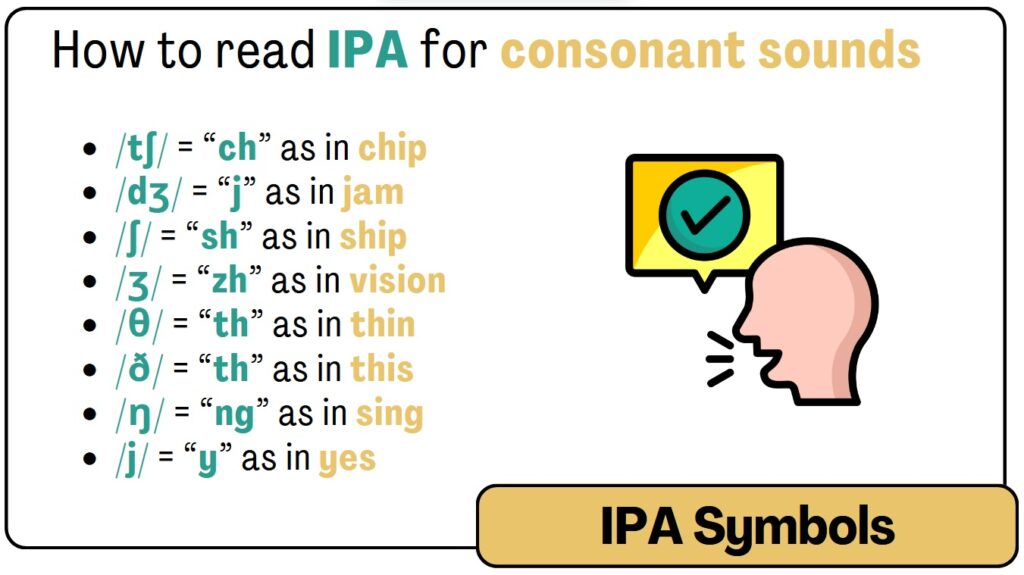
According to the Encyclopedia Britannica, linguists group them by manner of articulation.
The IPA symbols shown here map a single symbol to one sound:
- Stops fully close the path, then release. Examples of these are /p/ and /b/ in “pat” and “bat.”
- Fricatives squeeze air through a narrow gap. Examples of these are /f/ in “fan,” /v/ in “van,” /s/ in “sip”, and /z/ in “zip.”
- Affricates start as a stop and open into a fricative. Examples of these are /tʃ/ in “chip” and /dʒ/ in “jam.”
- Nasals send air through the nose. Examples of these are /m/ in “moon,” /n/ in “nine,” /ŋ/ in “sing.”
- Approximants shape the stream without a tight constriction. Examples of these are /w/ in “we,” /j/ in “yes,” /r/ in “red.”
- Lateral approximants allow air to flow around the sides of the tongue. The best example of this is the /l/ in “leaf.”
Read each one aloud and notice where your lips or tongue narrow to squeeze or “restrict” the air. Awareness of this makes learning to say these tricky clusters much easier.

Got a word or two that are tripping you up? Drop in your own examples into Undetectable’s Ask AI and ask for a quick pronunciation or spell check for the consonant sounds.
The tool gives plain-language explanations and allows you to save the answers to revisit later on.
The Complete List of Consonant Letters in English
The standard or “classroom list” of consonant letters is every letter except a, e, i, o, and u. This gives us the remaining 21 letters as consonants: b, c, d, f, g, h, j, k, l, m, n, p, q, r, s, t, v, w, x, y, z.
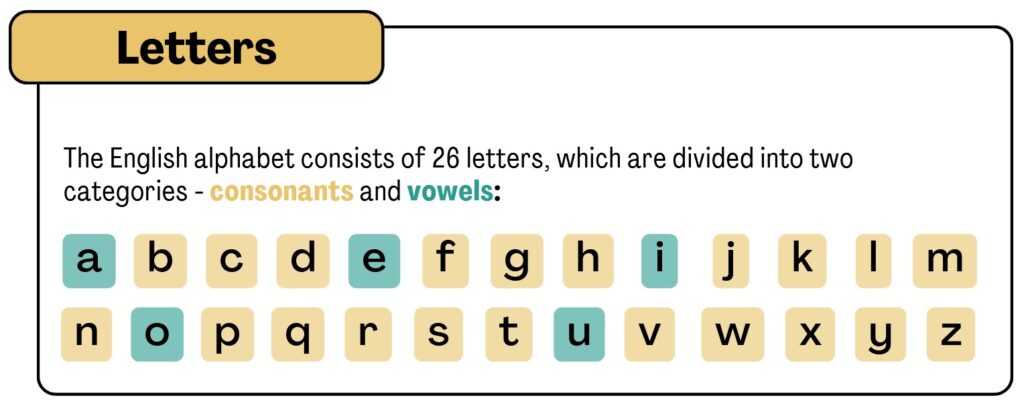
As we’ve already seen, the letters always stay the same, but the sounds definitely vary.
There are a few quick anchors that can help find your way around the variations in sound:
- c is /k/ in cat, and /s/ in city
- g has a hard sound in “go” and a soft sound in “giraffe”
- x marks /ks/ in “box”
- b as in “bat”
- f as in “fish”
- m as in “moon”
- r as in “rain”
- t as in “tap”
- z as in “zip”
“W” and “Y” are on the list as well, but we’ll take a closer look at their special roles next.
Sometimes “Y” Plus the Roles of “W” and “Y”
“Y” can play two roles. As a consonant, it leads a syllable with a glide, like with “yes” and “beyond.”
As a vowel, it replaces or teams up with vowel sounds, like “myth,” “gym,” “happy,” and “crystal.”
“W” can also switch roles. It’s a consonant when it’s at the start of “we” and “water.”
It becomes a vowel in words like “cow”, “snow,” and “growth”, where you hear what’s known as a diphthong (a single vowel sound made by gliding from one vowel to another) rather than a distinct w sound.
So, if you’re trying to identify consonants in a particularly tricky word, you can check the role sound first. Use the basic rule: sound first, spelling second.
Voiced vs. Voiceless Consonants (Plus a Throat Test)
Voiced consonants use your vocal cords and create a buzz when they come out, while voiceless consonants use only airflow and no buzz. To test these out, touch your throat while you speak.
If it vibrates, the consonant is voiced.
If it stays quiet, it’s voiceless.
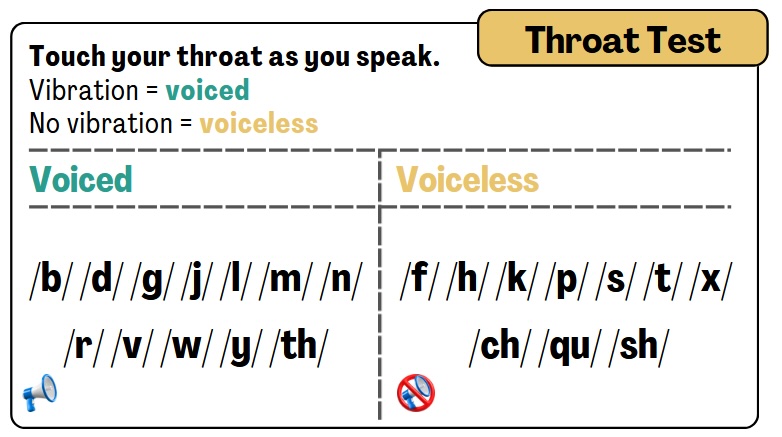
Try these pairs side by side: p b, t d, k g, f v, s z, ch j, th [thin], th [this]. Now say “fan van,” “sip zip,” “cheap jeep,” and “thin, this.”
You will notice that the shape of the mouth stays pretty much the same, but the buzz in your throat flips on and off.
Some accents will slightly fade the voicing at the end of words in casual speech.
Words like “dog” can feel less buzzy at the very end than in the middle of a sentence. Context keeps the meaning clear.
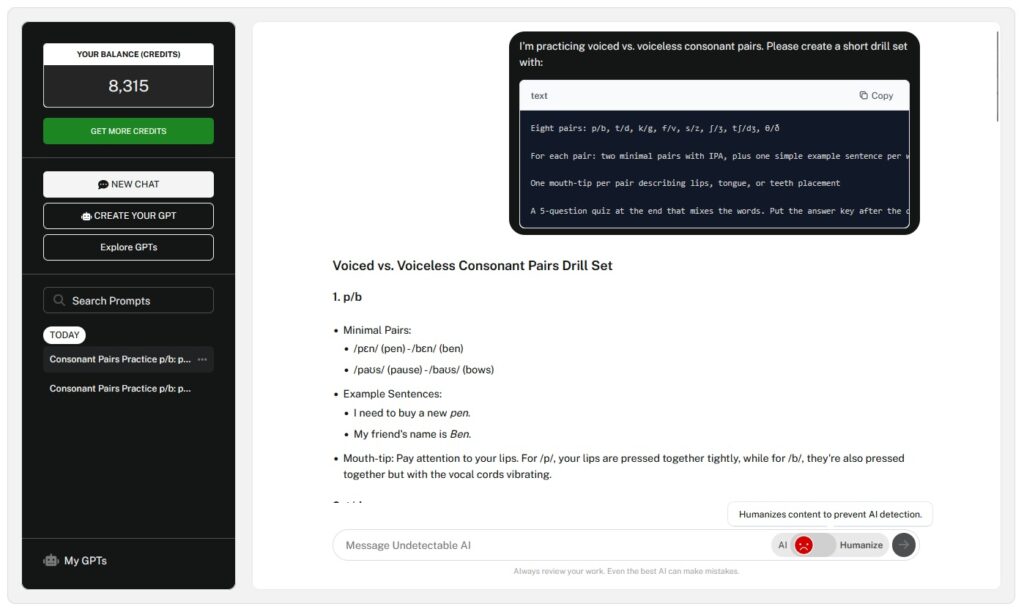
If you’re learning these pronunciations and need some guided practice, Undetectable’s AI Chat can help you generate minimal pairs, IPA, and mouth-position tips.
The humanization feature can also help you build short drills and flash cards and give you feedback on tricky sounds like a human would, not an AI.
Consonant Blends and Consonant Digraphs
Learners frequently mix up blends and digraphs because they look the same on the page.
Using the ear test can sort them out fast.
Blends are two or three letters where you can still hear each consonant sound. When you say them out loud, slowly, every sound pops out clearly.
- Two-letter blends: bl “blue,” br “broom,” cd “clap,” cr “crab,” dr “drink,” fl “flag,” fr “frog,” gl “glass,” gr “green,” pl “plane,” pr “price,” “sk “skate,” sl “slip,” sm “smile,” sn “snow,” sp “spin,” st “stop,” sw “swim,” tr “tree,” and tw “twin.”
- Three letters are more complex, but you can hear the distinct three sounds of each consonant: spr “spring,” str “street,” spl “splash,” and scr “scrape.”
Digraphs are two letters that make only one sound. Cover either letter, and the sound turns singular.
- Core consonant digraphs: cd “chip,” sh “ship,” th “thin/this,” ph “photo,” wh “what,” ck “back,” and ng in “sing.”
- Spelling pairs that behave like one consonant sound: kn “knee” (/n/), wr “write” (/r/), gh “laugh” (/f in some words).
It’s complicated. There’s a reason why the English language can be so difficult to learn for non-native speakers. Here’s a quick way to see if you’ve got a blend or a digraph:
Put your finger over one letter.
- If a full sound still remains, you’ve got a blend. Cover the b and l in “blue” and you still get a clean b or l sound in “bend” and “lend.”
- If the sound falls apart, you’ve got a digraph. Cover the sh in “ship” and the sh sound completely disappears.
Advanced mode: Mixed clusters. Words like thr “three” or shr “shrink” start off with a digraph (th, sh) plus an extra consonant.
Use Undetectable AI’s AI Chat to ask whether you’re dealing with a mixed cluster if you’re unsure. It’s a great way to help out with your English language study.
Vowel vs Consonant in Real Usage (The a vs an Question)
The article (a/an/the) choice should always be made by sound first. Think about it.
When we’re using acronyms in writing, such as MBA or HVAC, we’re naturally inclined to use the article “a” because we’re not dealing with a vowel as the first letter.
Say them both out loud with the article “a.” Sounds awkward, right?
The correct usage for the article here is “an” — “he earned an MBA,” we installed an HVAC system.”
This is because we use “an” before a vowel sound and “a” before a consonant sound. For example: an honor, an hour, but also a university, a European, a one-time offer.
As recommended by Cambridge, if the first sound opens like a vowel, pick “an.” If it starts with a clear consonant sound (remember your airway blocking), pick “a.”
If a phrase looks weird, read it out loud and trust the first sound.
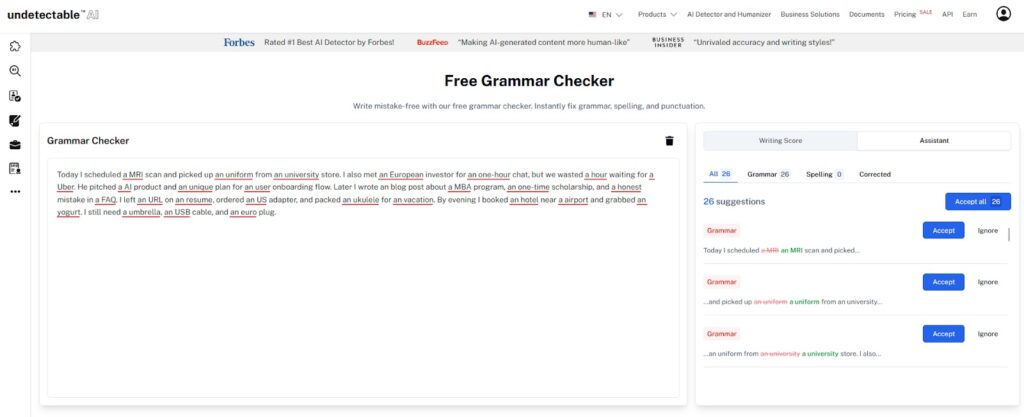
To make absolutely sure, run your writing through our free Undetectable AI’s Grammar Checker to have it flag any a/an mistakes in context.
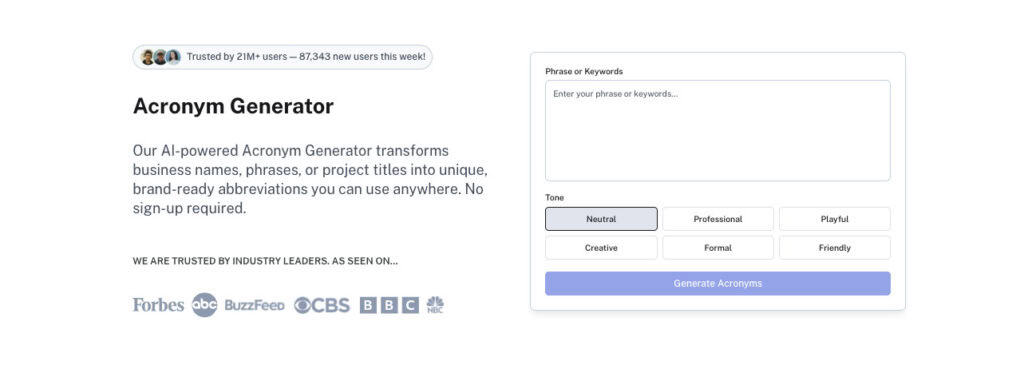
Understanding the skeleton of English words becomes much easier when you can identify how specific letter patterns repeat across different fields of study.
Additionally, if you want to see these phonetic rules in action within professional contexts, Undetectable AI’s Acronym Generator allows you to see how consonants are used to form distinct and recognizable abbreviations, helping you practice the “a vs. an” rule with modern technical initialisms.
Consonants and Syllable Structure
A syllable has three parts: An onset (starting consonant cluster), the nucleus (the vowel), and a coda (ending consonants).
It’s typical for the English language to slack blends at the start, so st, spr, and tr lead a lot of words. For example: stop (CCVC) and spring (CCVCC).
Codas too, can pile up, which is why words like “texts,” “glimpsed,” or “world” feel heavy to say.
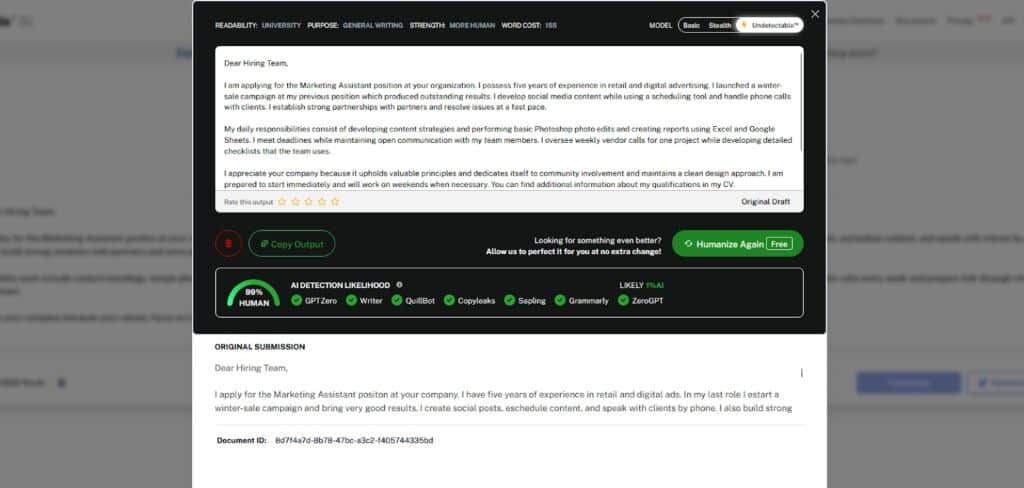
If a line still reads awkwardly to you, even after you break the cluster, try Undetectable AI’s AI Humanizer to smooth out the phrasing.
It works just as well on human-written text as it does for AI-generated content, and is very helpful for ESL students to see where they are misunderstanding or making English language mistakes.
Join thousands of professionals using our AI Detector and Humanizer—available below.
Make Your Consonants and Words Pop
You’ve met the parts that shape English sounds.
You can hear a consonant pop, tell a blend from a digraph, and pick a or an by ear. Keep that momentum going. Read aloud as much as possible, build small drills, and notice how your mouth moves.
The practice of language skills proves more important than natural ability.
The tools at Undetectable AI provide valuable benefits to both second-language English learners and native speakers who want to enhance their writing skills.
The Ask AI tool provides answers, while the AI Chat function helps with grammar discussions, and the AI Humanizer checks your choices in their proper context.
With Undetectable AI’s Ask AI, AI Chat, Grammar Checker, and AI Humanizer, you can refine your grammar, improve sentence flow, and ensure your writing reads naturally.
Undetectable AI enables you to refine your writing with complete confidence.
Try out Undetectable AI with a free trial today.
